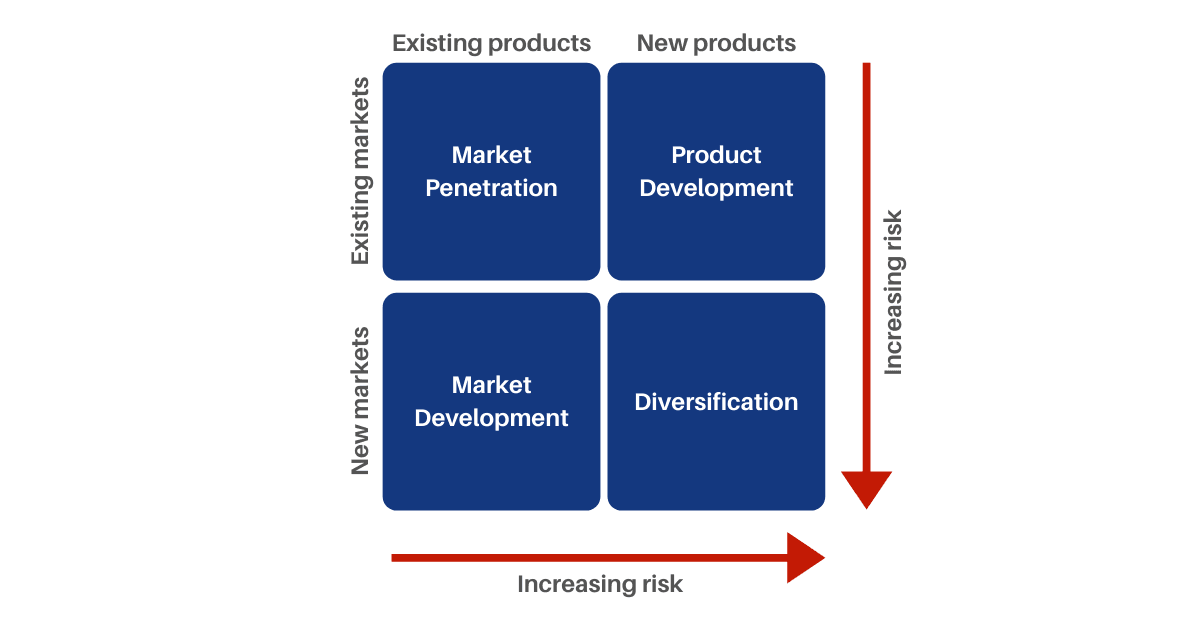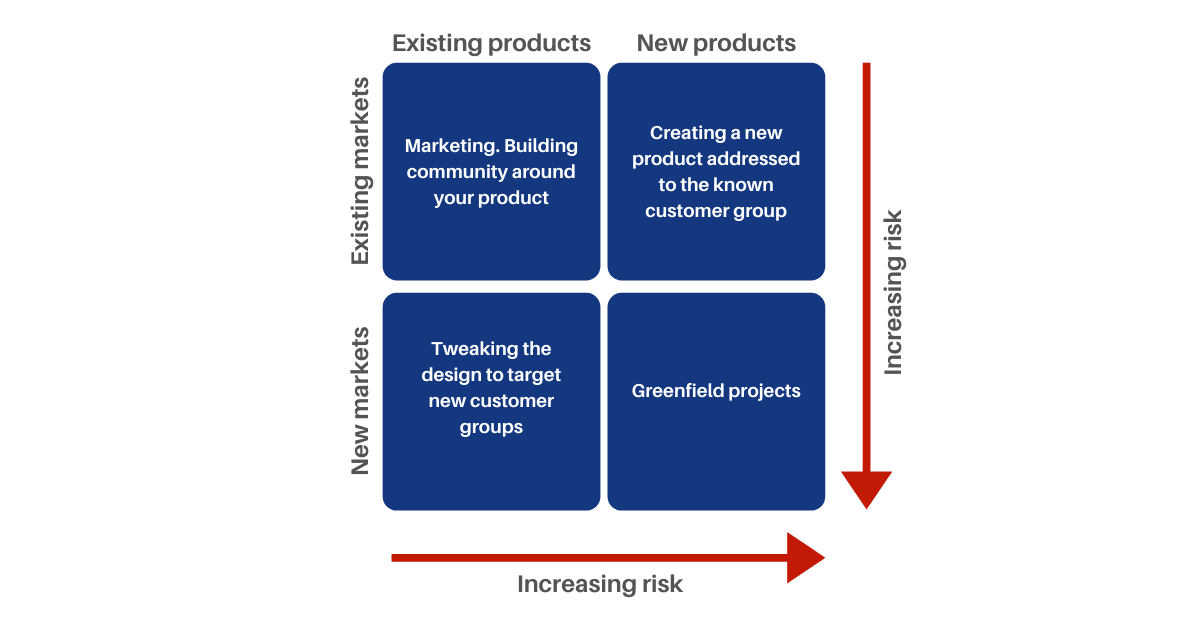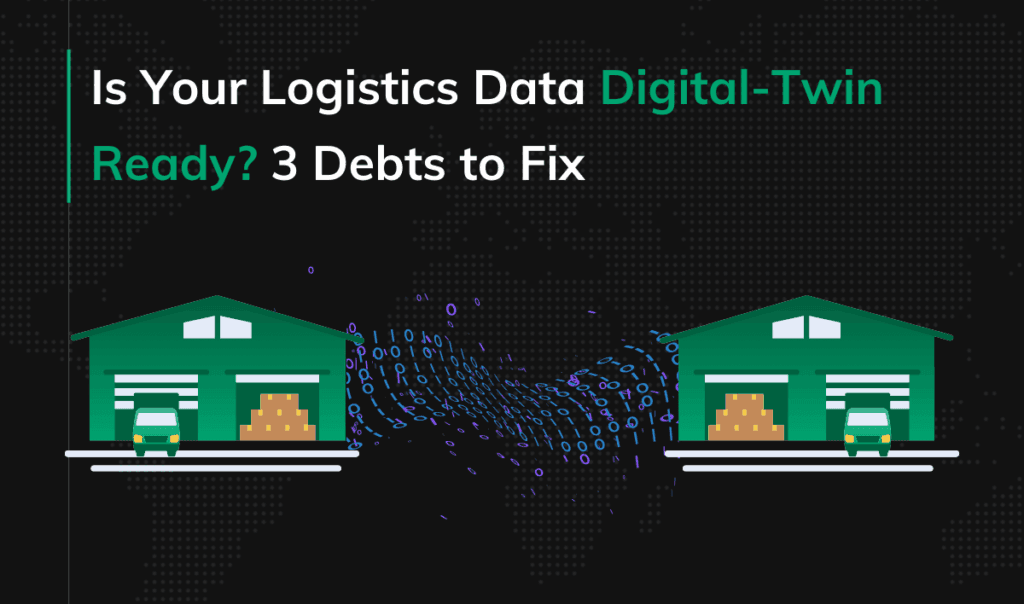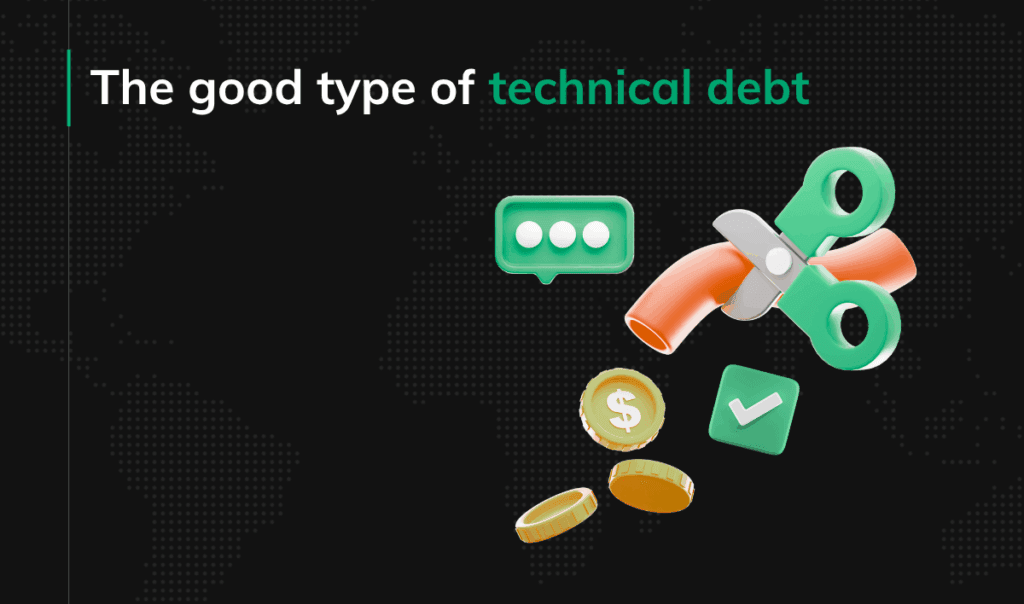How to apply Ansoff Matrix to scale up?

Ansoff Matrix is something you’re bound to come across when reading about business. Although this tool is already over 60 years old, it’s still handy when planning how to scale up the company. After all, it’s the pragmatic approach to use the tools that work regardless of how old they are. Getting familiar with the Ansoff Matrix doesn’t require any advanced skills. When you realize how the Ansoff Matrix works, all you’re going to need to apply it to your company is an open mind and a notebook. We hope that sounds promising enough to make you keep reading.
What is the Ansoff Matrix?
Technically speaking, the Ansoff Matrix is a grid consisting of 4 squares. Its more intuitive name is Product/Market Expansion Grid. Each square represents a different growth strategy. The basic assumption behind the matrix is that in order to grow, the company needs to modify its product, the target market, or both. The strategies in the grid represent combinations of product and market modifications. We know that it might not sound too intuitive at the moment, but we will discuss those approaches in more detail later on. For now, we will only mention that the risk factor is represented as well. In a nutshell, whenever you introduce a new product or enter a new market with your existing one, the risk grows bigger.
Take a look at the picture below. This is the classic Ansoff Matrix.

Market Penetration – old product; old market
The first growth strategy is called Market Penetration. The goal of this approach is to increase the market share of your current product. It’s easy to figure out, even without using any tools, that this is a safe game. Depending on your product, though, there might be not much to gain.
Still, if you decide this is the way to go, what can you do?
There are three main options:
- invest in marketing
- attract customers with new pricing
- buy your competition.
Those options seem very limited. However, the sole word “marketing” creates many possibilities. When used thoughtfully, this strategy is a good method to start. After all, if you plan on expansion, you need to build a solid base first. It’s only pragmatic.
Market Development – old product; new market
Let’s say you’ve already dominated your primary market. You are happy with your product, and you don’t feel like developing a new one. Market Development is the right strategy for you. The risk here is slightly more significant than with the Market Penetration, but the stake is also higher. Putting it in simple words – you are going to look for another market for your existing product. How do you do it?
Here is the list of your options:
- go outside of your city or country
- target a different demographic group
- add new sales channel (start your on-line store or open one in the real world).
Market Development is clearly a more demanding growth option. It requires a lot of marketing effort, and at some point, it may also require slight changes in your product. But even with this in mind, you have to pay attention to the fact that the growth potential is also significant. This refers especially to expanding internationally.
Product Development – new product; old market
There might be many reasons why the two strategies related to expanding the market are not for you. Whatever they are, here is the approach related to developing a new product. It’s called, what a surprise, Product Development. It entails introducing a new product into the market you already know. According to the Ansoff Matrix, the risk of such an endeavor is similar to the Market Development’s approach risk.
The most obvious way to do it is to go through your persona and other data about your existing customer base and look for the needs you might cater to.
If you need different ideas, here are a few:
- buy rights to someone else’s product
- join forces with another entrepreneur
- repackage your existing product.
If you want to scale up your company, developing a new product is something you are going to face sooner or later. It is up to you to decide if it’s the right time to do it.
Diversification – new product; new market
Diversification is the riskiest growth strategy. It means introducing a completely new product into a completely new market. Nevertheless, we know you’ve done it at least once. Did you enjoy it? Are you ready to do it again? If the answer is “yes,” here are two ways in which you can do it.
Related diversification
Related diversification happens when your product and your new market are somehow connected to the previous ones. A real-world example is the leather shoes manufacturer who starts producing wallets and belts. They might use the expertise they gathered while running the previous venture. Still, they are selling new products to a slightly different customer group.
Unrelated diversification
What’s unrelated diversification? It’s basically starting everything from scratch. It might be scary since you once again sail into the unknown waters. The risk is also, without any doubt, significant. So why bother? The answer is simple. If this venture succeeds, you are the owner of two profitable companies operating independently. This is the way empires are built. And more down to Earth, this is the situation in which your financial future is secured.
How to apply the Ansoff Matrix to scale up the digital company?
We believe that right now you have a fairly good understanding of what the Ansoff Matrix is and how it works. But how to apply it to digital products? This question is still waiting for the answer.
In this section, we will guide you through each quadrant of the Ansoff Matrix using digital examples. When you are done reading it, you should be able to apply the Product/Market Expansion Grid to your company with ease.
Let’s start by having a quick glance at the modified version of the Ansoff Matrix below:

If you are interested in the post about scaling your company with the use of Ansoff Matrix, we assume two things about you:
- you own (or co-own) a company
- your business is reasonably successful by now.
Both are excellent news. Congratulations!
Digital Market Penetration – old product; old market
Nevertheless, now is the time to go for more. Pragmatically, it’s a good idea to start with the lowest risk and expand your market share. With this growth strategy, your options for the digital product are basically the same as for the “regular” one. It can be expressed by paraphrasing the famous (or infamous) quote by Bill Clinton: “The marketing, stupid.”
The best way to increase the market penetration for your product, digital or not, is to market it. What is slightly different for digital one is that you can solely focus on digital marketing. Why? Because both your clients and your prospective clients are already familiar with the internet. What can you do?
- You can work on your social media presence.
- You can start building a community around your product.
- You can think of your own unique concept. After all, the digital world is still expanding. Maybe you can partner with a game development studio and get your product into their game?
Market Development for a digital product – old product; new market
What to do when your marketing campaign worked beyond your expectations? Or maybe you feel that you want more, that it’s time to change something, to move forward? Market Development strategy is a way to do so at a reasonable pace. We know “one can never consent to creep when one feels an impulse to soar” (Helen Keller), right? Well, not necessarily in business. When doing business, you have to keep a pragmatic approach and always have the risk in mind. But you already know that, don’t you?
Anyway, what can you do with your digital product to introduce it to the new market without significant risk and costs? Have you thought of tweaking the design a bit? If you don’t target needs that are specific to a particular customer group, maybe there is an easy way to target another one? Think about accessibility. Sometimes changing minor things like fonts or contrast can significantly improve experience for new customer groups.
Don’t forget to keep your eyes open for novelties. Did you know that voice search is going big right now? If you think of it now, you can be one of the early adopters. It usually pays off.
Digital Product Development – new product; old market
In the section above, we talked about the case when there is no need to work on an entirely new product. You keep your battle-tested solution, but you try to sell it in a slightly different way. Tweaking your product, adding a new sales channel – those growth strategies are more about the business and less about technology. Digital Product Development approach is, on the other hand, mostly about technology.
What can you do to scale your business using this strategy? You probably have all the data about your customers by now. Look at it carefully. Can you see any problems they might have? Maybe you can even ask them? After all, they trust you. They’ve already bought your product once.
When you manage to find the problem you may solve, it’s all the known drill. You build an MVP; you release it; you test it and tweak it until it’s perfect. Yet, this time it will be easier. You already have customers. You can market directly to them. You can try to sell your new product and your old product as a package. You can offer discounts, etc. Possibilities are limited only by your imagination.
(Digital) Diversification – new product; new market
Finally, we’ve arrived at the last growth strategy from the Ansoff Matrix. If you feel that your company is doing great and you need a challenge, this is the one for you. Why? Because with Diversification, you basically start over. You build something from scratch (again). In our pragmatic view, the key to even consider this strategy is having a healthy and prosperous business. A solid base allows you to risk and invest some of the money into something new. Such an approach reduces the risk associated with Diversification, yet, it does not reduce the potential profit. Having said that, how do you use Diversification to scale up your business? There are two ways.
Related (digital) Diversification
In related Diversification, you stay within the digital world. How is it different from Market Development and Product Development then? Well, within the Market Development approach, you sell the same product to new customers. You may need to play with the design, packaging or apply some minor changes, but the core of the product remains the same. Within the Product Development approach, you introduce a new product, but you sell it to your existing customers.
When you diversify your business, you sell a new product to new customers. Let’s say your product is a calendar app. If you decide to introduce a fancy reminder app, that would be Product Development. People using your calendar are likely to be interested in a reminder as well. But, if you decide to design a photo editing app, that’s diversifying your business. People using calendars on their phones do not necessarily need photo editors. Yet, the digital world is something you are familiar with. Even with this new market, you can at least partially rely on your experience.
Unrelated
Unrelated diversification is, you wouldn’t guess, unrelated to anything you’ve done before. If you decide to pursue this growth strategy, it doesn’t matter what you are doing now. You can open a restaurant; you can start a bakery or begin selling board games.
Conclusion
The Ansoff Matrix is a kind of tool that can be referred to as old but gold. It was first described in the 1950s when the world was a completely different place. It was way before the invention of the internet. Yet, more than 60 years later, it can still be successfully applied to scale companies, including digital ones.
If you enjoyed this article, you might also like:







